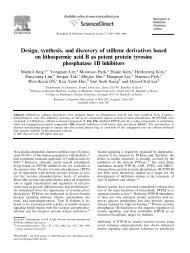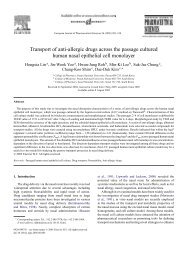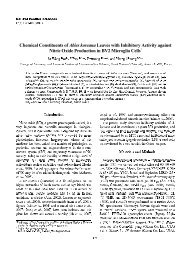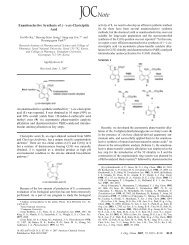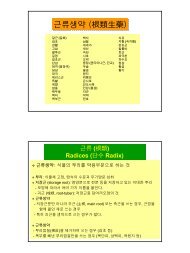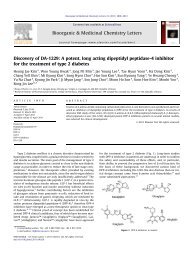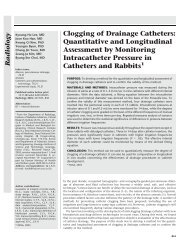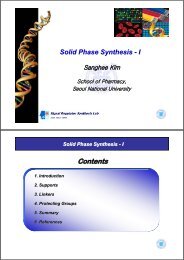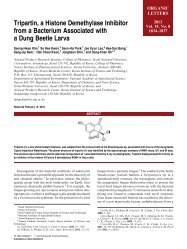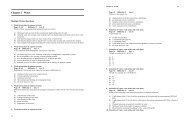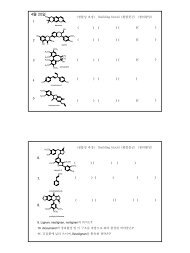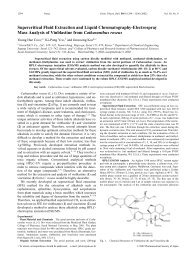Phenolic compounds with radical scavenging and cyclooxygenase-2
Phenolic compounds with radical scavenging and cyclooxygenase-2
Phenolic compounds with radical scavenging and cyclooxygenase-2
Create successful ePaper yourself
Turn your PDF publications into a flip-book with our unique Google optimized e-Paper software.
Bioorganic & Medicinal Chemistry 17 (2009) 2689–2694Contents lists available at ScienceDirectBioorganic & Medicinal Chemistryjournal homepage: www.elsevier.com/locate/bmc<strong>Phenolic</strong> <strong>compounds</strong> <strong>with</strong> <strong>radical</strong> <strong>scavenging</strong> <strong>and</strong> <strong>cyclooxygenase</strong>-2 (COX-2)inhibitory activities from Dioscorea oppositaMin Hye Yang a , Kee Dong Yoon a , Young-Won Chin a , Ju Hyun Park b , Jinwoong Kim a, *a College of Pharmacy <strong>and</strong> Research Institute of Pharmaceutical Science, Seoul National University, Seoul 151-742, South Koreab R&D Institute, Tong Yang Moolsan Co., Ltd, Nonsan 320-922, South KoreaarticleinfoabstractArticle history:Received 24 December 2008Revised 19 February 2009Accepted 21 February 2009Available online 5 March 2009Keywords:Dioscorea oppositaDioscoreaceae<strong>Phenolic</strong> <strong>compounds</strong>Cyclooxygenase-2 inhibitorsAntioxidantPhytochemical studies of the chloroform soluble fraction of Dioscorea opposita resulted in the isolation offour new <strong>compounds</strong>, 3,5-dihydroxy-4-methoxybibenzyl (1), 3,3 0 ,5-trihydroxy-2 0 -methoxybibenzyl (2),10,11-dihydro-dibenz[b,f]oxepin-2,4-diol (3), <strong>and</strong> 10,11-dihydro-4-methoxy-dibenz[b,f]oxepin-2-ol (4),together <strong>with</strong> an additional fifteen known <strong>compounds</strong>. The structures of 1–4 were elucidated by spectroscopicmethods including 2D NMR. All of the nineteen isolated <strong>compounds</strong> were tested in the DPPH,superoxide anion <strong>radical</strong> <strong>scavenging</strong> assays <strong>and</strong> <strong>cyclooxygenase</strong>s (COXs) inhibition assay. Of those, <strong>compounds</strong>7, 9, 11, 12, 13, 15 <strong>and</strong> 18 exhibited <strong>radical</strong> <strong>scavenging</strong> activities <strong>and</strong> <strong>compounds</strong> 2, 3, 8, 13, 15<strong>and</strong> 16 showed selective inhibitory activities against COX-2.Ó 2009 Elsevier Ltd. All rights reserved.1. IntroductionInflammatory responses occur by diverse mechanisms includingbiosynthesis of prostagl<strong>and</strong>ins, thromboxanes, prostacyclins<strong>and</strong> leukotrienes via <strong>cyclooxygenase</strong>s (COXs) <strong>and</strong> lipoxygenases(LOXs) activation. 1 Unregulated inflammation causes damage to abroad range of human organ <strong>and</strong> tissues, which can result in a varietyof disorders such as atherosclerosis, rheumatoid arthritis (RA),<strong>and</strong> chronic obstructive pulmonary disease (COPD). 2 Thus, therehave been many efforts to find new <strong>compounds</strong> retaining potentanti-inflammatory efficacy but less toxicity to other organs. Cyclooxygenase(COX) enzymes play key roles in the induction ofinflammatory diseases via synthesis of prostagl<strong>and</strong>ins H 2 , <strong>and</strong> theyexist as three isoforms: <strong>cyclooxygenase</strong>-1 (COX-1), expressed inmost cells constitutively, inducible <strong>cyclooxygenase</strong>-2 (COX-2),triggered by pro-inflammatory stimuli, <strong>and</strong> COX-3, present mainlyin the cerebral cortex <strong>and</strong> human heart. 3,4 Despite of the undesiredside effects such as increased cardiovascular risk of COX-2-selectiveinhibitors, much research spanning many years has been focusedon finding COX-2 selective inhibitors, owing to theremarkable reduction of adverse gastrointestinal <strong>and</strong> renal effectsassociated <strong>with</strong> conventional non-steroidal anti-inflammatorydrugs (NSAIDs) as well as to their potential therapeutic benefitsin several diseases, including certain types of cancer. 5–7* Corresponding author. Tel.: +82 2 880 9175; fax: +82 2 887 8509.E-mail address: jwkim@snu.ac.kr (J. Kim).According to recent studies, reactive oxygen species (ROS) areimportant mediators that initiate <strong>and</strong> propagate inflammatory responsesby stimulating release of pro-inflammatory cytokines suchas interleukin-1b (IL-1b) <strong>and</strong> tumor necrosis factor (TNF-a). 8 It wasalso found that ROS induced by activated neutrophils, eosinophils,monocytes <strong>and</strong> macrophages during the inflammation processleads to tissue injury by damaging macromolecules <strong>and</strong> effectingthe lipid peroxidation of membranes. 9 This indicates that free <strong>radical</strong>scavengers might be a useful means of attenuating inflammatoryeffects. Recently, two potent antioxidants, resveratrol <strong>and</strong>curcumin, were reported to inhibit COX-2 expression to a greateror lesser extent. 10,11Dioscorea opposita Thunb. (Dioscoreaceae) has been cultivatedin China, Japan <strong>and</strong> Korea as a food, <strong>and</strong> widely used as a traditionalmedicine, for a very long time. Phytochemical investigationsof D. opposita have revealed many chemical components such aspurine derivatives, phenanthrenes, stilbenes, sapogenins <strong>and</strong> saponins.12,13 Pharmacological studies have shown that the genus Dioscoreaexerts significant anti-inflammatory activity against TNF-a,IL-1b, COX-2 <strong>and</strong> inhibits the formation of ROS. 14,15 However, therehas been no trial conducted to find certain ingredients exhibitinganti-inflammatory activity. Therefore, it is necessary to identifythe chemical constituents of D. opposita responsible for the beneficialinhibitory effect against COX-2 via regulation of the ROS level.In the present study, two new dihydrostilbenes (1, 2) <strong>and</strong> twonew dibenzoxepins (3, 4) along <strong>with</strong> fifteen known <strong>compounds</strong>(Fig. 1) were isolated from the chloroform soluble fraction of D.opposita rhizomes, <strong>and</strong> their antioxidative activities were evaluated0968-0896/$ - see front matter Ó 2009 Elsevier Ltd. All rights reserved.doi:10.1016/j.bmc.2009.02.057
2690 M. H. Yang et al. / Bioorg. Med. Chem. 17 (2009) 2689–2694against DPPH <strong>and</strong> superoxide anion <strong>radical</strong>s, as well as in an in vitroCOX-2 inhibitory assay.2. Results <strong>and</strong> discussion2.1. Identification of new <strong>compounds</strong>Compound 1 was obtained as a colorless amorphous powderhaving the molecular formula C 15 H 16 O 3 , as determined by the observedmolecular ion peak [M] + at m/z 244.1102 in HREIMS. TheEIMS fragmentation pattern of 1 indicated the presence of a benzyl(m/z 91, C 7 H + 7 ) <strong>and</strong> a dihydroxymethoxybenzyl (m/z 153, C 8 H 9 O + 3 ).It also showed typical benzenoid UV absorption at 236 nm. The 1 HNMR spectrum of 1 (Table 1) revealed a singlet of two equivalentprotons at d H 6.19 (2H, s, H-2 <strong>and</strong> H-6) of ring B, five aromatic protonsat d H 7.13 (1H, t, J = 7.2 Hz, H-4 0 ), 7.14 (2H, dd, J = 7.2, 1.8 Hz,H-2 0 <strong>and</strong> H-6 0 ) <strong>and</strong> 7.22 (2H, t, J = 7.2 Hz, H-3 0 <strong>and</strong> H-5 0 ), a methoxygroup at d H 3.75 (3H, s) <strong>and</strong> four benzylic protons at d H 2.66 (2H, m,H-a) <strong>and</strong> 2.83 (2H, m, H-b). The HMBC cross-peaks between the 4-OCH 3 proton <strong>and</strong> C-4 as well as between H-2/H-6 (d H 6.19) <strong>and</strong> C-4proved that the methoxy group was placed between two hydroxygroup-substitutedcarbon atoms. The positions of H-a <strong>and</strong> H-balso were identified from an analysis of the HMBC correlations.Therefore, compound 1 was designated as 3,5-dihydroxy-4-methoxybibenzyl.The HREIMS data of compound 2 exhibited a molecular ion peakat m/z 260.1032 suggesting the molecular formula C 15 H 16 O 4 . TheEIMS fragmentation pattern of 2 indicated fragments of a dihydroxybenzyl(m/z 123, C 7 H 7 O þ 2) <strong>and</strong> a hydroxy-methoxybenzyl (m/z 137, C 8 H 9 O þ 2). Its UV spectrum also exhibited the typical patternof bibenzyl moiety at 243 nm. The 1 H NMR spectrum of 2 showedthe presence of 1,3,5-trisubstituted benzene ring at d H 6.08 (1H, t,J = 2.0 Hz, H-4) <strong>and</strong> 6.16 (2H, s, H-2 <strong>and</strong> H-6), three consecutiveprotons of ring A at d H 6.63 (1H, dd, J = 7.5, 1.7 Hz, H-6 0 ), 6.67(1H, dd, J = 8.1, 1.7 Hz, H-4 0 ) <strong>and</strong> 6.81 (1H, t, J = 8.0 Hz, H-5 0 ), amethoxy group at d H 3.74 (3H, s) <strong>and</strong> typical benzylic protons atd H 2.66 (2H, m, H-a) <strong>and</strong> 2.85 (2H, m, H-b). The detailed assignmentsof ring A were confirmed by HMBC experiment. Correlationsof the 2 0 -OCH 3 proton, H-4 0 <strong>and</strong> H-b to C-2 0 suggested that themethoxy group was attached to the C-2 0 position. Given the correlationof H-6 0 to C-b, the structure of ring A was consequentlydetermined to be an unusual 1,2,3-trisubstituted benzyl. The positionsof H-a <strong>and</strong> H-b were also assigned according to the HMBCdata. On the basis of these spectral data, compound 2 was identifiedas 3,3 0 ,5-trihydroxy-2 0 -methoxybibenzyl.Compound 3 was isolated as a white amorphous powder. Itsmolecular formula, <strong>with</strong> reference to the observed HREIMS ([M] +m/z 228.0783, calcd 228.0786), was deduced as C 14 H 12 O 3 . The presenceof a bibenzyl skeleton was suggested by the UV spectrum thatshowed absorption at 245 nm. The 1 H NMR spectrum (Table 2)showed four consecutive aromatic protons of ring A at d H 6.98(1H, m, H-8), 7.10 (1H, m, H-7), 7.12 (1H, dd, J = 8.4, 1.6 Hz, H-9)<strong>and</strong> 7.27 (1H, dd, J = 8.4, 1.6 Hz, H-6), two meta-substituted protonsignals of ring B at d H 6.06 (1H, d, J = 2.9 Hz, H-1) <strong>and</strong> 6.19 (1H, d,J = 2.9 Hz, H-3) <strong>and</strong> four benzylic protons at d H 2.97 (2H, m, H-11)<strong>and</strong> 3.08 (2H, m, H-10). The 13 C NMR data of 3 was similar to thoseof 2,4-dihydroxy-9,10-dihyrdophenanthrene, except for the chemicalshifts of six carbons (C-4, C-6, C-1a, C-4a, C-6a <strong>and</strong> C-9a). 16Notably, the 13 C resonances of the carbon atoms directly attachedto oxygen atom showed strong downfield shifts of ca. 23 ppm.These markedly downfield shifted signals at C-4a (from d C 115.1to 138.40) <strong>and</strong> C-6a (from d C 134.8 to 157.40) were assumed tobe the formation of a 4a, 6a-oxygen bridge. The assumption of thisoxygen bridged structure was supported by the mass data. Themolecular formula of compound 3 (C 14 H 12 O 3 , m/z 228) showed amass higher by 16 (one oxygen atom) compared to 2,4-dihydroxy-9,10-dihyrdophenanthrene(C 14 H 12 O 2 , m/z 212). The HMBCcorrelations from H-1 to C-11/C-4a <strong>and</strong> from H-3 to C-4/C-4a enabledthe completion of the locating of the hydroxy groups in thisstructure. The structure of 3 was thus identified as 10,11-dihydrodibenz[b,f]oxepin-2,4-diol.The HREIMS of 4 showed a [M] + ion at m/z 242.0952 consistent<strong>with</strong> the molecular formula C 15 H 14 O 3 . The UV spectrum showed abibenzyl moiety at 242 nm. The 1 H <strong>and</strong> 13 C NMR spectra of 4 (Table2) were very close to those of 3, excepting the additional signal forthe methoxy (d H 3.82) group. The location of the methoxy groupwas assigned based on the observed correlations in the HMBC<strong>and</strong> NOESY experiments. The HMBC spectrum of the methoxy protonat d H 3.82 <strong>and</strong> H-3 to C-4 suggested that the methoxy groupwas attached to C-4 in ring B. Furthermore, the NOESY correlationsbetween the 4-OCH 3 proton <strong>and</strong> H-3 <strong>and</strong> between H-1 <strong>and</strong> H-11(Fig. 2) confirmed a 2-hydroxy-4-methoxy benzene moiety. Thestructure of 4, then, was determined to be 10,11-dihydro-4-methoxy-dibenz[b,f]oxepin-2-ol.The 15 known <strong>compounds</strong> were identified, by comparison ofthe spectroscopic data ( 1 H NMR, 13 C NMR <strong>and</strong> MS) <strong>with</strong> the litera-Table 1NMR spectroscopic data (400 MHz, CD 3 OD) for <strong>compounds</strong> 1 <strong>and</strong> 2 aPositiond Cb1 2d H (J in Hz) HMBC d C d H (J in Hz) HMBC1 140.0, qC 146.6, qC2 109.5, CH 6.19 (1H, s) 3, 4, 6, a 108.7, CH 6.16 (1H, s) 3, 4, 6, a3 152.2, qC 160.2, qC4 135.7, qC 102.0, CH 6.08 (1H, t, 2.0) 2, 3, 5, 65 152.2, qC 160.2, qC6 109.5, CH 6.19 (1H, s) 2, 4, 5, a 108.7, CH 6.16 (1H, s) 2, 4, a1 0 144.0, qC 137.6, qC2 0 130.1, CH 7.14 (1H, dd, 7.2, 1.8) 1 0 ,6 0 148.0, qC3 0 130.3, CH 7.22 (1H, t, 7.2) 1 0 ,2 0 ,4 0 ,5 0 152.0, qC4 0 127.6, CH 7.13 (1H, t, 7.2) 2 0 ,6 0 116.3, CH 6.67 (1H, dd, 8.1, 1.7) 2 0 ,6 05 0 130.3, CH 7.22 (1H, t, 7.2) 1 0 ,3 0 ,4 0 ,6 0 126.0, CH 6.81 (1H, t, 8.0) 1 0 ,3 06 0 130.1, CH 7.14 (1H, dd, 7.2, 1.8) 1 0 ,2 0 122.6, CH 6.63 (1H, dd, 7.5, 1.7) 4 0 ,ba 39.8, CH 2 2.66 (2H, m) 2, 6 39.3, CH 2 2.66 (2H, m) 1, 2, 6, 1 0 ,bb 39.8, CH 2 2.83 (2H, m) 2 0 ,6 0 33.9, CH 2 2.85 (2H, m) 1, 1 0 ,2 0 ,6 0 ,a4-OCH 3 61.6, CH 3 3.75 (3H, s) 42 0 -OCH 3 61.7, CH 3 3.74 (3H, s) 2 0abChemical shifts are reported in ppm relative to residual CD 3 OD resonance at 3.31 ppm for 1 H NMR <strong>and</strong> CD 3 OD resonance at 49 ppm for 13 C NMR.Multiplicity was confirmed by HMQC.
M. H. Yang et al. / Bioorg. Med. Chem. 17 (2009) 2689–2694 2691Table 2NMR spectroscopic data (500 MHz, CD 3 OD) for <strong>compounds</strong> 3 <strong>and</strong> 4 aPositiond Cb3 4d H (J in Hz) HMBC d C d H (J in Hz) HMBC1 106.1, CH 6.06 (1H, d, 2.9) 2, 3, 11, 4a 106.7, CH 6.18 (1H, d, 2.7) 2, 3, 11, 4a2 153.3, qC 152.3, qC3 100.9, CH 6.19 (1H, d, 2.9) 1, 2, 4, 4a 98.5, CH 6.29 (1H, d, 2.7) 1, 2, 4, 4a4 148.8, qC 152.0, qC6 120.7, CH 7.27 (1H, dd, 8.4, 1.6) 8, 6a, 9a 121.6, CH 7.23 (1H, dd, 8.2, 1.5) 8, 6a, 9a7 126.7, CH 7.10 (1H, m) 9, 6a 127.1, CH 7.11 (1H, m) 9, 6a8 123.5, CH 6.98 (1H, m) 6, 9a 123.7, CH 6.98 (1H, dd, 8.5, 1.5) 6, 9a9 130.2, CH 7.12 (1H, dd, 8.4, 1.6) 7, 10, 6a, 9a 130.8, CH 7.07 (1H, dd, 8.5, 1.5) 7, 10, 6a, 9a10 30.7, CH 2 3.08 (2H, m) 9, 11, 1a, 6a, 9a 31.0, CH 2 3.07 (2H, s) 9, 11, 1a, 6a, 9a11 30.2, CH 2 2.97 (2H, m) 1, 10, 1a, 4a, 9a 30.2, CH 2 3.07 (2H, s) 1, 10, 1a, 4a, 9a1a 133.7, qC 135.3, qC4a 138.4, qC 141.0, qC6a 157.4, qC 157.1, qC9a 131.6, qC 131.0, qC4-OCH 3 56.1, CH 3 3.82 (3H, s) 4abChemical shifts are reported in ppm relative to residual CD 3 OD resonance at 3.31 ppm for 1 H NMR <strong>and</strong> CD 3 OD resonance at 49 ppm for 13 C NMR.Multiplicity was confirmed by HMQC.ture values, as six dihydrostilbenes, including batatasin I 17 (5),batatasin IV 18 (6), tristin 19 (7), 2 0 ,3,5-trihydroxybibenzyl (8) 18 ,2 0 ,4-dihydroxy-3,5-dimethoxybibenzyl 20 (9) <strong>and</strong> 3,4-dimethoxy-2 0 -hydroxybibenzyl 21 (10); three phenanthrenes, including 3,5-dimethoxy-2,7-phenanthrenediol 22 (11), hircinol 23 (12) <strong>and</strong> 9,10-dihydro-7-methoxy-2,5-phenanthrenediol 24 (13); five diarylheptanoids,including (1E,4E,6E)-1,7-bis(4-hydroxyphenyl)-1,4,6-heptatrien-3-one25 (14), (4E,6E)-7-(4-hydroxy-3-methoxyphenyl)-1-(4-hydroxyphenyl)-4,6-heptadien-3-one 26 (15), (4E,6E)-1,7-bis(4-hydroxyphenyl)-4,6-heptadien-3-one 27 (16), (3R,5R)-3,5-dihydroxy-1, 7-bis(4-hydroxyphenyl)-3,5-heptanediol 28 (17) <strong>and</strong> (3R,5R)-1,7-bis(4-hydroxy-3-methoxyphenyl)-3,5-heptanediol 28 (18), <strong>and</strong>apigenin 29 (19).2.2. Radical <strong>scavenging</strong> activityIt is commonly considered that ROS such as hydrogen peroxide(H 2 O 2 ), hydroxy <strong>radical</strong> (OH ) <strong>and</strong> superoxide anion <strong>radical</strong> (O 2 )are generated in a situation of oxidative stress <strong>and</strong> play a key rolein cellular damage leading to various inflammatory diseases. 30 Severalpapers have demonstrated that ROS are highly connected <strong>with</strong>the inflammatory process via activation of membrane phospholipaseA 2 (PLA 2 ) which catalyzes the biotransformation of arachidonicacids (AAs) to prostagl<strong>and</strong>ins <strong>and</strong> thromboxanes byTable 3Antioxidant activities of <strong>compounds</strong> (1–19) isolated from D. opposita aCompound DPPH <strong>radical</strong> IC 50 b (lg/mL) Superoxide <strong>radical</strong> IC 50 b (lg/mL)1 37.5 ± 1.8 >1002 46.7 ± 0.1 >1004 40.6 ± 1.2 >1007 35.2 ± 0.5 51.6 ± 0.59 28.8 ± 1.0 56.3 ± 0.811 31.4 ± 0.8 39.6 ± 1.112 63.8 ± 2.3 62.4 ± 1.013 43.0 ± 1.8 51.5 ± 0.315 40.0 ± 2.1 38.8 ± 1.316 >100 44.1 ± 0.518 12.3 ± 0.2 48.7 ± 0.6Catechin c 13.5 ± 0.5 13.7 ± 0.4Ascorbic acid c 19.2 ± 1.1 16.7 ± 0.8aCompounds 3, 5, 6, 8, 10, 14, 17 <strong>and</strong> 19 were considered to be inactive(IC 50 > 100 lg/mL).b Each value is expressed as the mean of triplicate experiments.c Positive control.COX. 31,32 In addition, ROS are directly produced by COX at the siteof inflammation <strong>and</strong> amplify the acute phase of the inflammatoryresponses. 33 Thus, antioxidative <strong>and</strong> <strong>radical</strong> <strong>scavenging</strong> agentscan attenuate COX-mediated inflammatory processes by counteractingthe effects of ROS.In the present study, 19 <strong>compounds</strong> from the chloroform-solublefraction of D. opposita were tested to evaluate their antioxidativeactivity against both DPPH <strong>and</strong> superoxide anion <strong>radical</strong>s<strong>and</strong> to evaluate the structure–activity relationship (SAR) of eachclass of phenolic <strong>compounds</strong>. Among the nineteen <strong>compounds</strong>, 7,9, 11, 12, 13, 15 <strong>and</strong> 18 exhibited mild inhibitory activities againstboth DPPH <strong>and</strong> superoxide anion <strong>radical</strong>s, whereas <strong>compounds</strong> 1, 2<strong>and</strong> 4 just neutralized DPPH <strong>radical</strong> <strong>and</strong> compound 16 showedantioxidative activity against superoxide <strong>radical</strong>. The other <strong>compounds</strong>showed no <strong>radical</strong>-<strong>scavenging</strong> activity (see Table 3).Two dihydrostilbenes possessing a para-hydroxy group in theA- or B-ring, 3,4 0 ,5-trihydroxy-3 0 -methoxybibenzyl (7) <strong>and</strong> 2 0 ,4-dihydroxy-3,5-dimethoxybibnezyl (9) showed antioxidative effectsagainst both DPPH <strong>and</strong> superoxide <strong>radical</strong>s, but the otherdihydrostilbene derivatives did not. These results indicated thatthe para-hydroxy group played a significant role in its <strong>radical</strong> <strong>scavenging</strong>capacity, <strong>and</strong> are in accordance <strong>with</strong> the results for resveratrol<strong>and</strong> its analogues. 34,35Among the five diarylheptanoids (14–18) having two para-hydroxygroups in benzene rings, just (4E,6E)-7-(4-hydroxy-3-methoxyphenyl)-1-(4-hydroxyphenyl)-4,6-heptadien-3-one (15)<strong>and</strong> (3R,5R)-1,7-bis(4-hydroxy-3-methoxyphenyl)-3,5-heptanediol(18) exhibited relatively strong inhibitory activities against bothDPPH <strong>and</strong> O 2<strong>radical</strong>s, demonstrating that the 30 <strong>and</strong> 3 00 methoxygroups at the ortho-position of the benzene ring are essential tothe <strong>radical</strong> <strong>scavenging</strong> activity of diarylheptanoid derivatives,which fact is supported by a previous report demonstrating thatmethoxy groups in curcuminoids significantly improved the <strong>radical</strong><strong>scavenging</strong> activity. 362.3. Inhibition of COXs in vitroAs shown in Table 4, <strong>compounds</strong> 2, 3, 7, 8, 11, 13, 14, 15 <strong>and</strong> 16showed inhibitory activity against COXs. Among these nine <strong>compounds</strong>,2, 3, 8, 13, 15 <strong>and</strong> 16 inhibited COX-2 specifically, thenew compound 2 showing the most potent inhibitory activity <strong>with</strong>the COX-2 selectivity at >55.6. Curcumin <strong>and</strong> its derivatives havebeen regarded as an efficient natural anti-inflammatory agent, 37<strong>and</strong> the structures of the diarylheptanoids, isolated in this study,
2692 M. H. Yang et al. / Bioorg. Med. Chem. 17 (2009) 2689–2694R 6R 5 R 43' 2' a4'A1'b1R 13B4R 25R 31 R 1 = OH; R 2 = OCH 3 ; R 3 = OH; R 4 = H; R 5 = H; R 6 = H2 R 1 = OH; R 2 = H; R 3 = OH; R 4 = OCH 3 ; R 5 = OH; R 6 = H5 R 1 = OH; R 2 = H; R 3 = OCH 3 ; R 4 = H; R 5 = OH; R 6 = H6 R 1 = OH; R 2 = H; R 3 = OCH 3 ; R 4 = OH; R 5 = H; R 6 = H7 R 1 = OH; R 2 = H; R 3 = OH; R 4 = H; R 5 = OCH 3 ; R 6 = OH8 R 1 = OH; R 2 = H; R 3 = OH; R 4 = OH; R 5 = H; R 6 = H9 R 1 = OCH 3 ; R 2 = OH; R 3 = OCH 3 ; R 4 = OH; R 5 = H; R 6 = H10 R 1 = OCH 3 ; R 2 = OCH 3 ; R 3 = OH; R 4 = OH; R 5 = H; R 6 = H9 108a1aR 5725a 4a R 15 4 3R 4 R 3 R 211 R 1 = OH; R 2 = OCH 3 ; R 3 = H; R 4 = OCH 3 ; R 5 = OH12 9,10-dihydro; R 1 = OH; R 2 = H; R 3 = OCH 3 ;R 4 = OH; R 5 = H13 9,10-dihydro; R 1 = OH; R 2 = H; R 3 = H; R 4 = OH; R 5 = OCH 31"O1 3 5 7 1' 3'RR3"1"OHOH1 3 5 7 1' 3'RHO4"4'OHHO4"4'OH14 R = H15 1,2-dihydro; R = OCH 316 1,2-dihydro; R = H17 R = H18 R = OCH 310 1199a 1a1A B6a O 4a64RO3 R = H4 R= CH 32OHFigure 1. Structures of phenolic <strong>compounds</strong> 1–18 isolated from chloroform fraction of D. opposita.Table 4Inhibitory effects of <strong>compounds</strong> (1–19) isolated from D. opposita on ovine COX-1<strong>and</strong>COX-2 activity in vitro aCompound COX-1 IC 50 b (lg/ml) COX-2 IC 50 b (lg/ml) COX-2 selectivity c2 >100 1.8 ± 0.3 >55.63 >100 6.4 ± 0.6 >15.67 4.7 ± 0.3 4.7 ± 0.1 1.08 >100 19.5 ± 1.5 >5.111 3.0 ± 0.4 2.7 ± 0.7 1.113 >100 10.6 ± 0.2 >9.414 5.8 ± 0.8 3.2 ± 0.2 1.815 >100 7.7 ± 1.0 >13.016 >100 4.9 ± 1.5 >20.4Indomethacin d 0.27 ± 0.0 0.2 ± 0.1 1.4aCompounds 1, 4, 5, 6, 9, 10, 12, 17, 18 <strong>and</strong> 19 were considered to be inactive(IC 50 > 100 lg/ml) in both COX-1 <strong>and</strong> COX-2.b Each value is expressed as the mean of triplicate experiments.c COX-2 selectivity was determined by IC 50, COX-1 /IC 50, COX-2 .d Positive control.have similar structures to the curcumin skeleton. Compound 14, 15<strong>and</strong> 16, possessing ketone moiety, inhibited COXs, 15 <strong>and</strong> 16 showingselective inhibitory activity against COX-2, implying that 1,2-dihydrogenation plays an important role in COX-2 selectivity.However, <strong>compounds</strong> 17, 18, <strong>with</strong>out the ketone group, showedno inhibitory activity against COXs.3. ConclusionNOESYHMBCPhytochemical <strong>and</strong> pharmacological studies on the chloroformsolublefraction of D. opposita were conducted to find the moleculesexhibiting antioxidative <strong>and</strong> inhibitory activity against COXs.Two new dihydrostilbenes <strong>and</strong> two new dibenzoxepins togetherOH 3 COOHFigure 2. Selected HMBC <strong>and</strong> NOESY correlations of compound 4.
M. H. Yang et al. / Bioorg. Med. Chem. 17 (2009) 2689–2694 2693<strong>with</strong> fifteen known <strong>compounds</strong>, were isolated, <strong>and</strong> six of themshowed selective COX-2 inhibitory activity. Among them, compound2 showed the most potent COX-2 inhibitory activity <strong>with</strong>the selectivity at >55.6. Based on the comparison of the structures<strong>and</strong> potencies, the para-hydroxy substituents in the dihydrostilbene<strong>and</strong> methoxy groups at the ortho-position in diarylheptanoidplayed a key role in attenuating ROS. In the case of the diarylheptanoids,the <strong>compounds</strong> possessing both ketone moiety <strong>and</strong> hydrogenatedC-1 in one molecule were more potent than the others.However, there does not appear to be any relationship betweenCOX-2 inhibitory activity <strong>and</strong> antioxidant activity.4. Experimental4.1. General methods1 H <strong>and</strong> 13 C NMR, COSY, HMQC, HMBC <strong>and</strong> NOESY spectral datawere run on Bruker AVANCE 400 <strong>and</strong> 500 spectrometer. EIMS <strong>and</strong>HREIMS were recorded on JEOL JMS 700 spectrometer. UV spectrawere measured on a Beckman DU 605 spectrophotometer. IR spectraldata were taken on a JASCO FT/IR-4200 IR spectrophotometer.RP-MPLC was carried using a ISCO Combiflash instrument <strong>with</strong> aUV/vis detector (UA-6). A Gilson HPLC system (Gilson, USA) wasused to isolate <strong>compounds</strong>, <strong>and</strong> was equipped <strong>with</strong> two 321pumps, a UV/vis-151 detector, an autosampler 234 <strong>and</strong> a fractioncollector 204. Silica gel (230–400 mesh, Merck) <strong>and</strong> SephadexLH-20 gel (Pharmacia, Sweden) were used in column chromatography.DPPH (1,1-diphenyl-2-picrylhydrazyl), xanthine, xanthineoxidase, nitroblue tetrazolium (NBT), catechin, ascorbic acid werepurchased from Sigma-Aldrich (St. Louis, MO, USA). Cyclooxygenaseassay kits were purchased from Cayman Chemical (MI, USA).4.2. Plant materialThe rhizomes of D. opposita Thunb. (Dioscoreaceae) were providedby Tong Yang Moolsan Co., Ltd (Nonsan, South Korea), <strong>and</strong>identified by Prof. Gwang Jin Chang of the Korea National AgriculturalCollege. A voucher specimen (SNUPH-0822) has been depositedin the Medicinal Herb Garden, Seoul National University.4.3. Extraction <strong>and</strong> isolationFresh rhizomes of D. opposita (60 kg) were sliced <strong>and</strong> extracted<strong>with</strong> MeOH (20 L 3) <strong>and</strong> evaporated under reduced pressure. TheMeOH extract (1.9 kg) was suspended in distilled water (3 L) <strong>and</strong>partitioned <strong>with</strong> CHCl 3 (3 L), EtOAc (3 L) <strong>and</strong> n-BuOH (3 L), sequentially.The chloroform soluble fraction (72 g) was subjected to silicagel CC (CHCl 3 -MeOH (30:1)?100% MeOH) to yield 12 fractions(Frs. 1-12). Fraction 2 (9.3 g) was subjected to MPLC (Redisep C-18 RP, 30 150 mm; detection, UV at 220 nm; flow rate, 20 mL/min) <strong>with</strong> a gradient elution of MeOH–H 2 O (50:50?100% MeOH)to yield 10 subfractions (Frs. 2-1–2-10). Fraction 2-1 (0.8 g) wassubjected to HPLC (YMC-pack ODS-A C18, 250 10 mm; eluent,MeCN–H 2 O (50:50); detection, UV at 254 nm; flow rate, 4 mL/min) to yield <strong>compounds</strong> 3 (3.5 mg, t R 29 min) <strong>and</strong> 11 (4.1 mg, t R24.5 min). Compounds 1 (6.9 mg, t R 17.3 min) <strong>and</strong> 9 (4 mg, t R15.5 min) from fraction 2-2 (1.8 g) <strong>and</strong> <strong>compounds</strong> 4 (3.5 mg, t R20.5 min), 12 (41.9 mg, t R 19 min) <strong>and</strong> 15 (7.8 mg, t R 14 min) fromfraction 2-4 (1.5 g) were isolated by HPLC (YMC-pack ODS-A C18,250 10 mm; eluent, MeCN–H 2 O (70:30); detection, UV at254 nm; flow rate, 4 mL/min). Fraction 3 (7.2 g) was subjected toMPLC (Redisep C-18 RP, 30 150 mm; detection, UV at 220 nm;flow rate, 20 mL/min) <strong>with</strong> a gradient elution of MeOH–H 2 O(50:50?100% MeOH) to obtain 9 fractions (Frs. 3-1–3-9). Fraction3-2 (1.9 g) was subjected to HPLC (YMC-pack ODS-A C18,250 10 mm; eluent, MeCN–H 2 O (40:60); detection, UV at254 nm; flow rate, 4 mL/min) to give <strong>compounds</strong> 5 (20.5 mg, t R23 min), 6 (39.6 mg, t R 27.8 min), 10 (3.4 mg, t R 27.1 min) <strong>and</strong> 13(7.6 mg, t R 19.7 min). Fraction 3-4 (0.5 g) was subjected to HPLC(YMC-pack ODS-A C18, 250 10 mm; eluent, MeCN–H 2 O(40:60); detection, UV at 254 nm; flow rate, 4 mL/min) to yieldcompound 16 (17 mg, t R 27 min). Fraction 4 (7.8 g) was subjectedto MPLC (Redisep C-18 RP, 30 150 mm; detection, UV at220 nm; flow rate, 20 mL/min) <strong>with</strong> a gradient elution of MeOH–H 2 O (50:50?100% MeOH) to yield 8 fractions (Frs. 4-1–4-8). Fraction4-1 (1.2 g) <strong>and</strong> 4-3 (0.8 g) were subjectd to HPLC (YMC-packODS-A C18, 250 10 mm; eluent, MeCN–H 2 O (45:55); detection,UV at 254 nm; flow rate, 4 mL/min) to yield <strong>compounds</strong>18 (14 mg, t R 16 min) <strong>and</strong> 19 (6.4 mg, t R 20.4 min). Compound14 (2.2 mg, t R 27 min) was isolated from fraction 4-4 (520 mg)by HPLC (YMC-pack ODS-A C18, 250 10 mm; eluent, MeCN–H 2 O (50:50); detection, UV at 254 nm; flow rate, 4 mL/min).Fraction 5 (6.5 g) was subjected to MPLC (Redisep C-18 RP,30 150 mm; detection, UV at 220 nm; flow rate, 20 mL/min)<strong>with</strong> a gradient elution of MeCN–H 2 O (20:80?90:10) to yield5 fractions (Frs. 5-1–5-5). Compounds 2 (13.8 mg, t R 34.4 min)<strong>and</strong> 7 (6.4 mg, t R 30.6 min) were isolated from fraction 5-1(0.8 g) by HPLC (YMC-pack ODS-A C18, 250 10 mm; eluent,MeCN–H 2 O (30:70); detection, UV at 254 nm; flow rate, 4 mL/min). Fraction 6 (4.3 g) was subjected to MPLC (Redisep C-18RP, 30 150 mm; detection, UV at 220 nm; flow rate, 20 mL/min) <strong>with</strong> a gradient elution of MeOH–H 2 O (20:80?100%MeOH) to yield 4 fractions (Frs. 6-1–6-4). Fraction 6-2 (1.2 g)was fractionated into 5 fractions (Frs. 6-2-1–6-2-5) using aSephadex LH-20 CC (MeOH). Subfractions 6-2-2 <strong>and</strong> 6-2-4 werepurified separately by HPLC (YMC-pack ODS-A C18,250 10 mm; eluent, MeCN–H 2 O (30:70); detection, UV at254 nm; flow rate, 4 mL/min) to yield <strong>compounds</strong> 8 (4.5 mg,t R 15.7 min) <strong>and</strong> 17 (23.7 mg, t R 20.2 min).4.3.1. 3,5-Dihydroxy-4-methoxy-bibenzyl (1)Colorless amorphous powder (MeOH); UV (MeOH) k max (loge)236 (4.36) nm; IR (neat) m max 3408, 2935, 1596, 1454, 1357,1170 cm 1 ; 1 H NMR (CD 3 OD, 400 MHz) <strong>and</strong> 13 C NMR (CD 3 OD,100 MHz) see Table 1; EIMS m/z 244 [M] + (29), 153 (100), 138(19), 110 (36), 91 (72); HREIMS m/z 244.1102 (calcd forC 15 H 16 O 3 , 244.1099).4.3.2. 3,3 0 ,5-Trihydroxy-2 0 -methoxy-bibenzyl (2)Brownish powder (MeOH); UV (MeOH) k max nm (loge) 243(4.62); IR (neat) m max 3376, 2927, 1599, 1471, 1155 cm 1 ; 1 HNMR (CD 3 OD, 400 MHz) <strong>and</strong> 13 C NMR (CD 3 OD, 100 MHz) see Table1; EIMS m/z 260 [M] + (90), 229 (28), 137 (100), 123 (51), 109 (99),77 (44); HREIMS m/z 260.1032 (calcd for C 15 H 16 O 4 , 260.1049).4.3.3. 10,11-Dihydro-dibenz[b,f]oxepin-2,4-diol (3)White amorphous powder (MeOH); UV (MeOH) k max nm (loge)245 (4.40); IR (neat) m max 3420, 2924, 1616, 1457 cm 1 ; 1 HNMR(CD 3 OD, 500 MHz) <strong>and</strong> 13 C NMR (CD 3 OD, 125 MHz) see Table 2;EIMS m/z 228 [M] + (100), 211 (17), 199 (30), 181 (27), 153 (35),128 (47), 115 (37), 69 (68); HREIMS m/z 228.0783 (calcd forC 14 H 12 O 3 , 228.0786).4.3.4. 10,11-Dihydro-4-methoxy-dibenz[b,f]oxepin-2-ol (4)Brownish powder (MeOH); UV (MeOH) k max nm (loge) 242(4.96); IR (neat) m max 3388, 2923, 1606, 1454, 1227 cm 1 ; 1 HNMR (CD 3 OD, 500 MHz) <strong>and</strong> 13 C NMR (CD 3 OD, 125 MHz) see Table2; EIMS m/z 242 [M] + (100), 227 (8), 211 (5), 199 (18), 181 (38), 153(16), 128 (16), 115 (15), 69 (13); HREIMS m/z 242.0952 (calcd forC 15 H 14 O 3 , 242.0943).
2694 M. H. Yang et al. / Bioorg. Med. Chem. 17 (2009) 2689–26944.4. Radical <strong>scavenging</strong> assay4.4.1. DPPH assayThe free <strong>radical</strong> <strong>scavenging</strong> activity of the <strong>compounds</strong> wereevaluated by the 2,2-diphenyl-1-picrylhydrazyl (DPPH) method<strong>with</strong> modifications. 38 Each compound (5 lL) was added to 316lM DPPH (95 lL) solution in 96 well plates. All of the <strong>compounds</strong>1–19 were tested in final concentrations of 1, 2, 5, 10, 20, 50, <strong>and</strong>100 lg/mL, respectively. The reaction mixture (100 lL) was mixedfor 1 min <strong>and</strong> incubated at room temperature (37 °C) for 30 min.Then, the absorbance was measured at 515 nm on a microplatereader. The DPPH <strong>radical</strong> <strong>scavenging</strong> activity was calculatedaccording to the equationDPPH <strong>radical</strong> <strong>scavenging</strong> activity ð%Þ ¼½1 ðA 1 A 2 Þ=A 0 Š100where A 0 was the absorbance of the control (<strong>with</strong>out the test compound),A 1 was the absorbance in the presence of the test compound,<strong>and</strong> A 2 was the absorbance sample blank (<strong>with</strong>out DPPH).Using a calibration curve <strong>with</strong> different concentrations of samples,the IC 50 was calculated. The IC 50 is the sample concentration reducing50% of the initial DPPH <strong>radical</strong>s under the given experimentalconditions.4.4.2. Superoxide <strong>radical</strong> (O 2 ) assayThe superoxide <strong>radical</strong> <strong>scavenging</strong> assay was performed bypublished methods <strong>with</strong> some modification. 39 O 2was generatedby xanthine/xanthine oxidase <strong>and</strong> measured in reference to the nitroblue tetrazolium (NBT) reduction. The final results were expressedas the percent inhibition of O 2production in thepresence of test compound. Different concentrations of test compound(0–0.1 mg/ml) in DMSO were added to 80 lL of a mixtureof 0.1 mM xanthine <strong>and</strong> 0.2 mM NBT in 0.05 M phosphate buffer(pH 7.4) containing 0.1 mM EDTA. Then, 10 lL of 0.8 U/ml xanthineoxidase diluted in 0.05 M phosphate buffer (pH 7.4) was added <strong>and</strong>incubated at 37 °C for 20 min. The reaction was stopped by adding1 M HCl. The absorbance was measured at 560 nm on a microplatereader. The inhibitory effect was calculated asInhibitory rate ð%Þ ¼½1 ðA 1 A 2 Þ=A 0 Š100where A 0 was the absorbance of the control (<strong>with</strong>out the test compound),A 1 was the absorbance in the presence of the test compound,<strong>and</strong> A 2 was the absorbance sample blank (<strong>with</strong>outxanthine oxidase). Using a calibration curve <strong>with</strong> different concentrationsof samples, the IC 50 was calculated. The IC 50 is the sampleconcentration reducing 50% of the initial superoxide <strong>radical</strong>s (O 2 )under the given experimental conditions.4.5. Cyclooxygenase (COX) inhibitor screening assayThe inhibitory activities against COX-1 <strong>and</strong> COX-2 were determinedusing a colorimetric COX (ovine) Inhibitor Screening AssayKit (Cayman Chemical Co., Cat. No. 760111) according to the manufacturer’sprotocol. 40 The inhibitory activities of the <strong>compounds</strong>were measured by monitoring the production of oxidizedN,N,N 0 ,N 0 -tetramethyl-p-phenylenediamine (TMPD) at 590 nm followedby incubation of either ovine COX-1 or COX-2 <strong>with</strong> arachidonicacid. The enzymes were preincubated for 5 min at 25 °C<strong>with</strong> the test <strong>compounds</strong> prior to addition of arachidonic acid (finalconcentration 1.1 mM) <strong>and</strong> TMPD <strong>and</strong> incubation for 5 min at25 °C. The COX-inhibiting activity was calculated according tothe equationCOX inhibiting activity ð%Þ ¼½1 ðA 1 A 2 Þ=A 0 Š100where A 0 was the absorbance of the control (<strong>with</strong>out the test compound),A 1 was the absorbance in the presence of the test compound,<strong>and</strong> A 2 was the absorbance sample blank (<strong>with</strong>out TMPD).The IC 50 is the concentration of tested <strong>compounds</strong> reducing 50%of ovine COX-1 or COX-2 under the given experimental conditions,<strong>and</strong> was calculated using a calibration curve <strong>with</strong> different concentrationsof samples.AcknowledgmentsThis study was financially supported by a Grant (PF0310108-00) from the Plant Diversity Research Center of the 21C FrontierR&D Programs.References <strong>and</strong> notes1. Jaggi, R.; Wurgler, U.; Gr<strong>and</strong>jean, F.; Weisei, M. Inflamm. Res. 2004, 53, 153.2. Ulloa, L. Nat. Rev. Drug Discov. 2005, 4, 673.3. Schwab, J. M.; Schluesener, H. J.; Meyermann, R.; Serhan, C. N. Prostagl<strong>and</strong>insLeukot. Essent. Fatty Acids 2003, 69, 339.4. Gadad, A. K.; Palkar, M. B.; An<strong>and</strong>, K.; Noolvi, M. N.; Boreddy, T. S.; Wagwade, J.Bioorg. Med. Chem. 2008, 16, 276.5. James, M. J.; Clel<strong>and</strong>, L. G. Curr. Opin. Clin. Nutr. Metab. Care 2006, 9, 89.6. Laine, L.; White, W. B.; Rostom, A.; Hochberg, M. Semin. Arthritis Rheu. 2008, 38,165.7. de Groot, D. J. A.; de Vries, E. G. E.; Groen, H. J. M.; de Jong, S. Crit. Rev. Oncol.Hemat. 2007, 61, 52.8. Geronikaki, A. A.; Gavalas, A. M. Comb. Chem. High Throughput Screening 2006, 9,425.9. Gutteridge, J. M. Clin. Chem. 1995, 41, 1819.10. Rahman, I.; Biswas, S. K.; Kirkham, P. A. Biochem. Pharmacol. 2006, 72, 1439.11. Leifert, W. R.; Abeywardena, M. Y. Nutr. Res. 2008, 28, 729.12. Irel<strong>and</strong>, C. R.; Schwabe, W. W.; Coursey, D. G. Phytochemistry 1981, 20, 1569.13. Ofelia, E.; Jesús, C. L.; Helgi, J.; Francisco, G. Phytochemistry 1982, 21, 413.14. Kim, M.-J.; Kim, H.-N.; Kang, K.-S.; Baek, N.-I.; Kim, D.-K.; Kim, Y.-S.; Kim, S.-H.;Jean, B.-H. Int. Immunopharmacol. 2004, 4, 1489.15. Lee, S.-J.; Lim, K.-T. Mol. Cell. Biochem. 2008, 317, 151.16. Stoessl, A.; Stothers, J. B. Org. Magn. Reson. 1982, 20, 166.17. Majumder, P. L.; Guha, S.; Sen, S. Phytochemistry 1999, 52, 1365.18. Fagboun, D. E.; Ogundana, S. K.; Adesanya, S. A.; Roberts, M. F. Phytochemistry1987, 26, 3187.19. Leong, Y.-W.; Harrison, L. J.; Powell, A. D. Phytochemistry 1999, 50, 1237.20. Kag<strong>and</strong>a, N. G.; Adesanya, S. A. J. Nat. Prod. 1990, 53, 1345.21. Jarevång, T.; Nilsson, M.-C.; Wallstedt, A.; Odham, G.; Sterner, O.Phytochemistry 1998, 48, 893.22. Leong, Y.-W.; Kang, C.-C.; Harrison, L. J.; Powell, A. D. Phytochemistry 1997, 44,157.23. Coxon, D. T.; Ogundana, S. K.; Dennis, C. Phytochemistry 1982, 21, 1389.24. Takai, S.; Yamaki, M.; Inoue, K. Phytochemistry 1983, 22, 1011.25. Nakayama, R.; Tamura, Y.; Yamanaka, H.; Kikuzaki, H.; Nakatani, N.Phytochemistry 1993, 33, 501.26. Moon, S.-S.; Cho, S.-C.; Lee, J.-Y. Bull. Korean Chem. Soc. 2005, 26, 447.27. Ali, M. S.; Tezuka, Y.; Awale, S.; Banstoka, A. H.; Kadota, S. J. Nat. Prod. 2001, 64,289.28. Yokosuka, A.; Mimaki, Y.; Sakagami, H.; Shida, Y. J. Nat. Prod. 2002, 65, 283.29. Shen, C.-C.; Chang, Y.-S.; Hott, L.-K. Phytochemistry 1993, 34, 843.30. Lazer, E. S.; Wong, H. C.; Possanza, G.; Graham, A. G.; Farina, P. R. J. Med. Chem.1989, 32, 100.31. Vane, J. Nature 1971, 231, 235.32. Scout, K. F.; Bryant, K. J.; Bidgood, M. J. J. Leukocyte Biol. 1999, 66, 535.33. McIntyre, M.; Bohr, D. F.; Dominiczak, A. F. Hypertension 1999, 34, 539.34. Lu, M.; Cai, Y. J.; Fang, J. G.; Zhou, Y. L.; Liu, Z. L.; Wu, L. M. Pharmazie 2002, 57,474.35. Ryu, G. S.; Ju, J. H.; Park, Y. J.; Ryu, S. Y.; Choi, B. W.; Lee, B. H. Arch. Pharm. Res.2002, 25, 636.36. Cai, Y.-Z.; Sun, M.; Xing, J.; Qiong, L.; Harold, C. Life Sci. 2006, 78, 2872.37. Mukhopadyay, A.; Basu, N.; Ghatak, N.; Gujral, P. K. Agents Actions 1982, 12,508.38. Gamez, E. J. C.; Luyengi, L.; Lee, S. K.; Zhu, L.-F.; Zhou, B.-N.; Fong, H. H. S.;Pezzuto, J. M.; Kinghorn, A. D. J. Nat. Prod. 1998, 61, 706.39. Cheng, Z.-J.; Kuo, S.-C.; Chan, S.-C.; Ko, F.-N.; Teng, C.-M. Biochim. Biophys. ActaLipid Lipid Metab. 1998, 1392, 291.40. Kulmacz, R. J.; L<strong>and</strong>s, W. E. M. Prostagl<strong>and</strong>ins 1983, 25, 531.



